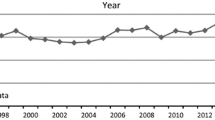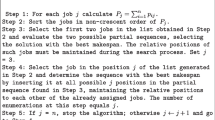Abstract
Information systems (IS) is a vital research area in both science and engineering, whose revolutions in terms of theories, techniques, and applications promote the evolution of human society. At the same time, the complexity and dynamics of IS raise the challenge for exploring the topic in detail. In this paper, we present a quantitative analysis on bibliographic dataset to reveal the evolution of information systems in 2 decades (1996–2015). We select 39,767 papers published in 8 top-tier journals and conferences between 1996 and 2015 and explore the anatomy from manifold. We find that IS is experiencing the sustainable growth phase in terms of increased productivity, impact, and collaboration. The field is benefited from collaborative, open-minded, and in-depth efforts evidenced from the growing number of co-authors per paper, the continual declining of self-citation rate, and increased reference age, respectively. By applying topic detection models on paper titles, abstracts, and keywords, we infer the representative topics and research directions, which can also reveal the research landscape within this field. Finally, we measure the temporal trends of topics and identify the innovative years in the 20 years’ development history of IS. These discoveries can benefit not only researchers in terms of promoting understanding of the entire field, but also governments for funding agencies.












Similar content being viewed by others
References
Arun, R., Suresh, V., Madhavan, C. V., & Murthy, M. N. (2010). On finding the natural number of topics with latent dirichlet allocation: Some observations. In Pacific-Asia conference on knowledge discovery and data mining (pp. 391–402). Springer.
Bai, X., Liu, H., Zhang, F., Ning, Z., Kong, X., Lee, I., et al. (2017). An overview on evaluating and predicting scholarly article impact. Information, 8(3), 73.
Bai, X., Zhang, F., Hou, J., Lee, I., Kong, X., Tolba, A., et al. (2018). Quantifying the impact of scholarly papers based on higher-order weighted citations. PLoS ONE, 13(3), e0193192.
Blei, D. M., Ng, A. Y., & Jordan, M. I. (2003). Latent dirichlet allocation. Journal of Machine Learning Research, 3, 993–1022.
Bollen, J., Van de Sompel, H., Hagberg, A., & Chute, R. (2009). A principal component analysis of 39 scientific impact measures. PLoS ONE, 4(6), e6022.
Cao, J., Xia, T., Li, J., Zhang, Y., & Tang, S. (2009). A density-based method for adaptive LDA model selection. Neurocomputing, 72(7–9), 1775–1781.
Correia, A., Paredes, H., & Fonseca, B. (2018). Scientometric analysis of scientific publications in CSCW. Scientometrics, 114(1), 31–89.
Finin, T., Cane, M., Sleeman, J., Halem, M., et al. (2016). Dynamic topic modeling to infer the influence of research citations on IPCC assessment reports. In Big data challenges, research, and technologies in the earth and planetary sciences workshop, IEEE int. conf. on big data.
Griffiths, T. L., & Steyvers, M. (2004). Finding scientific topics. Proceedings of the National Academy of Sciences, 101(suppl 1), 5228–5235.
Haslam, N., Ban, L., Kaufmann, L., Loughnan, S., Peters, K., Whelan, J., et al. (2008). What makes an article influential? Predicting impact in social and personality psychology. Scientometrics, 76(1), 169–185.
Hearst, M. A., Dumais, S. T., Osuna, E., Platt, J., & Scholkopf, B. (1998). Support vector machines. IEEE Intelligent Systems and Their Applications, 13(4), 18–28.
Hofmann, T. (2017). Probabilistic latent semantic indexing. In ACM SIGIR forum (Vol. 51, pp. 211–218). ACM.
Liu, J., Kong, X., Xia, F., Bai, X., Wang, L., Qing, Q., et al. (2018). Artificial intelligence in the 21st century. IEEE Access, 6, 34403–34421.
Ngo, G. H., Eickhoff, S. B., Fox, P. T., & Yeo, B. T. (2016). Collapsed variational bayesian inference of the author-topic model: Application to large-scale coordinate-based meta-analysis. In 2016 international workshop on pattern recognition in neuroimaging (PRNI) (pp. 1–4). IEEE.
Savov, P., Jatowt, A., & Nielek, R. (2017). Towards understanding the evolution of the WWW conference. In Proceedings of the 26th international conference on world wide web companion (pp. 835–836). International World Wide Web Conferences Steering Committee.
Sinatra, R., Deville, P., Szell, M., Wang, D., & Barabási, A.-L. (2015). A century of physics. Nature Physics, 11(10), 791.
Sinha, A., Shen, Z., Song, Y., Ma, H., Eide, D., Hsu, B.-J. P., & Wang, K. (2015). An overview of microsoft academic service (MAS) and applications. In Proceedings of the 24th international conference on world wide web (pp. 243–246). ACM.
Sun, L., & Yin, Y. (2017). Discovering themes and trends in transportation research using topic modeling. Transportation Research Part C Emerging Technologies, 77, 49–66.
Xu, Z., Chen, L., Dai, Y., & Chen, G. (2017). A dynamic topic model and matrix factorization-based travel recommendation method exploiting ubiquitous data. IEEE Transactions on Multimedia, 19(8), 1933–1945.
Yan, E., & Ding, Y. (2010). Weighted citation: An indicator of an article’s prestige. Journal of the Association for Information Science and Technology, 61(8), 1635–1643.
Yang, M., & Hsu, W. H. (2016). Hdpauthor: A new hybrid author-topic model using latent dirichlet allocation and hierarchical dirichlet processes. In Proceedings of the 25th international conference companion on world wide web (pp. 619–624). International World Wide Web Conferences Steering Committee.
Zhu, X., Turney, P., Lemire, D., & Vellino, A. (2015). Measuring academic influence: Not all citations are equal. Journal of the Association for Information Science and Technology, 66(2), 408–427.
Author information
Authors and Affiliations
Contributions
JL, FX, IL, and XK designed the research; JT performed the experiments; XK and FX analyzed the data; JL and IL wrote the paper. All authors reviewed the manuscript.
Corresponding author
Ethics declarations
Conflict of interest
The authors declare that they have no conflict of interest.
Rights and permissions
About this article
Cite this article
Liu, J., Tian, J., Kong, X. et al. Two decades of information systems: a bibliometric review. Scientometrics 118, 617–643 (2019). https://doi.org/10.1007/s11192-018-2974-5
Received:
Published:
Issue Date:
DOI: https://doi.org/10.1007/s11192-018-2974-5




